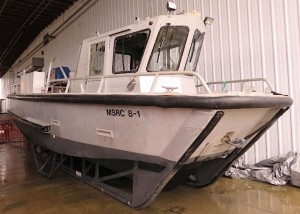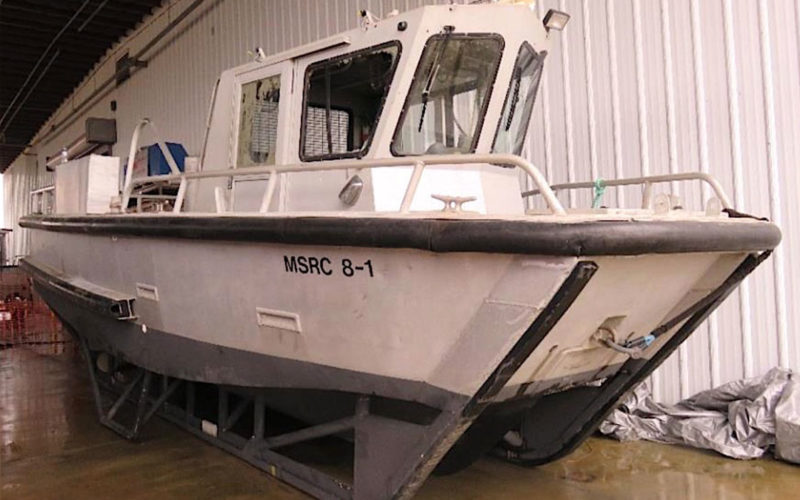A workboat that capsized and sank during a boom deployment exercise on the Lower Mississippi River, killing both people on board, turned broadside to the current moments before it rolled over.
National Transportation Safety Board (NTSB) investigators could not explain why MSRC 8-1 maneuvered abreast to the fast-moving river at mile 18 near Boothville, La., on Jan. 16, 2019. The abrupt turn to starboard placed the 32-foot boat in a perilous position, with the towline still connected to the oil spill response vessel (OSRV) Louisiana Responder.

“The static force that the boom towline exerted on (MSRC 8-1’s) H-bitt, combined with the force of the current broadside to the MSRC 8-1’s underwater hull, attached framework and large rudders, created a heeling moment which rolled the boat to port quickly, overcoming its inherent stability and capsizing it,” the NTSB said in its report.
Katelyn Carlisle, 24, and Ruben Arellano, 48, both of whom worked for the Marine Spill Response Corp. (MSRC), died in the incident despite feverish efforts by the MSRC crew, an Associated Branch Pilots crew and a Coast Guard rescue swimmer to save them. The incident happened at 1038.

MSRC, in a prepared statement, said the NTSB findings align with those from an investigation conducted on the group’s behalf by the American Bureau of Shipping (ABS). MSRC has since added buoyancy collars and towing guides on the stern of its 32-foot workboats to reduce the capsizing risk.
“Our commitment to our customers and our stakeholders is to be fully transparent about our learnings from this painful incident to prevent anything like it from occurring in the future,” MSRC spokeswoman Ceren Karaer said. “MSRC does not dispute the overall NTSB findings.”
The nonprofit MSRC is the largest oil spill response organization in the United States. It has vessels and equipment positioned on all three U.S. coasts, the Great Lakes and Hawaii to rapidly respond to pollution and spills. The 210-foot Louisiana Responder, based at Fort Jackson near Venice, La., carried myriad spill response equipment, including MSRC 8-1.
Munson Aluminum Boats built the 640-hp twin-screw MSRC 8-1 in 1992. It had an enclosed cabin with a crawl space accessible beneath the helm chair. The vessel’s gunwales had a series of cleats and small bitts, and a sturdier H-bitt was installed just aft of amidships.
Munson boats are common across the MSRC fleet, and they are routinely engaged in training exercises. Just a week earlier, another OSRV and its workboat performed the same maneuvers, in the same location with the same river conditions, without incident. MSRC records showed no previous accidents with its 32-foot Munson crafts, the NTSB report said.
Louisiana Responder left its dock at mile 20.4 at 0830 for the Boothville Anchorage a few miles downriver. There were seven MSRC responders on board, along with the ship’s typical six-person crew. An observer from the federal Bureau of Safety and Environmental Enforcement also came along.
The training exercise was typical for the oil spill responders. MSRC 8-1 was to deploy 660 feet of inflatable containment boom from Louisiana Responder’s stern. The small boat would make a “J” pattern with the boom that, in a real spill, could corral product on the surface while Louisiana Responder used skimmers to remove it.
Arellano and Carlisle boarded MSRC 8-1 after an extensive safety briefing. The weather was clear and calm, with the current running between 3 and 4 knots when the boat entered the water at about 0935. Arellano was at the controls while Carlisle handled the boom towline.
Carlisle secured the towline to a bitt on MSRC 8-1’s port bow. She then used a series of half-eights to secure roughly 55 feet of towline to the top of the H-bitt, rather than through it. Several senior responders observed her work, and they later told federal investigators she correctly secured the line.
In a typical evolution, the Munson boat backs away from Louisiana Responder until the boom is fully deployed, at which point crew secure the boom to the OSRV’s stern. Then, the smaller boat comes forward to slacken the towline while the deck hand removes it from the forward bitt. The Munson boat then repositions itself so the towline runs aft from the H-bitt.
That evolution went awry on the morning of the accident. The master and chief mate on Louisiana Responder watched MSRC 8-1 unexpectedly turn a few degrees to port after Carlisle removed the line from the forward bitt. “Then, seconds later, about 1038, they saw MSRC 8-1 come to starboard at a fast rate of turn, which put the boat perpendicular to the current,” the NTSB said.
The capsizing spurred a massive rescue effort. Louisiana Responder deployed its rescue craft within four minutes. Two ABs aboard the craft saw the Munson boat floating upside down roughly 760 feet away. They reached MSRC 8-1 and tapped the hull. The ABs got a response from Arellano. They also heard Carlisle’s voice inside the vessel. The two crewmembers were not in the same space.
The rescue boat could not move MSRC 8-1 against the current. Louisiana Responder hauled in the boom to bring the Munson boat toward its transom, where the crew hoped to right it with a crane. Meanwhile, at 1052, responders could no longer hear Carlisle. Crew aboard an approaching Associated Branch Pilots vessel could not find her in the water. Her body has not been recovered.
The Coast Guard deployed multiple assets, including a helicopter that dropped a rescue swimmer onto the pilot boat at about 1100. The response boat CG 45707 from Station Venice arrived at about the same time. The rescue swimmer entered the 43-degree water and proceeded to MSRC 8-1 but could not find a door handle. He tapped the hull and got a response from Arellano.
“The rescue swimmer told the man to follow his knocks on the hull back to the area where the cabin door was located,” the NTSB said. “When the operator got to the estimated location of the door, the rescue swimmer got back into the water and reached deep into the boat. However, he was still not able to locate the operator.”
Louisiana Responder ultimately hauled in all 660 feet of boom, but the towline snagged on the stern ramp, leaving the Munson boat upside down about 100 feet away. Further efforts to bring the boat toward the OSRV weren’t successful. MSRC 8-1 sank at 1122. Arellano was found inside the crawl space when MSRC 8-1 was salvaged Jan. 18.
Investigators tried to determine what caused the vessel to come broadside to the current, but they couldn’t pinpoint anything. They learned Arellano was trained and experienced handling the 32-foot Munson boat. They also determined that a mechanical failure likely did not occur. Drug and alcohol testing was negative.
“Therefore,” the NTSB report said, “the circumstances for which MSRC 8-1 turned perpendicular to and fell back with the current, with the boom towline under tension and still tethered to Louisiana Responder, are unknown.”
MSRC hired ABS to investigate the sinking and identify lessons that could improve safety. MSRC has shared those lessons with its customers, regulatory agencies, industry groups and other oil spill response organizations.
MSRC 8-1 was declared a constructive total loss with damage estimated at $250,000. A sheen of oil was reported on the water after the boat sank.

